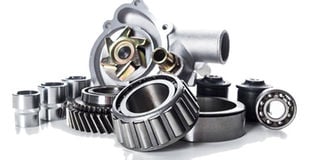Beware of fake spare parts

Learn how genuine car parts such as brake pads look like, where they are manufactured and how they are sealed. File photo.
What you need to know:
As the popularity and demand for motor vehicles continues to grow, the market for fake parts increases and for many unsuspecting owners, the prospect of a cheaper alternative may be tempting. But cutting costs could be fatal.
Approximately three months ago, John Naturinda took his Toyota Nadia to the garage for service. When his mechanic inspected the car, he recommended that he changes the crankshaft. He gave the mechanic Shs60,000 who rushed to Kisekka Market in downtown Kampala to buy a new one.
“After just two days, the car developed grinding sounds. When I took it to a different mechanic, he inspected the car and discovered that my crankshaft had been replaced with a fake one. It had not lasted for even a month,” Naturinda recalls.
It was until he was advised that genuine crankshafts for Toyota cars cost between Shs100,000 and Shs150,000 that he realised he had been cheated of the initial Shs60,000.
Eric Amadi, a mechanic at Dallas Auto Clinic in Ggaba, says fake car parts do not necessarily have to be new and sealed but they can, in some scenarios, be old. What you need to worry about is that some old parts are again sold to other motorists, all in the name of saving money.
How to identify fake spare parts
Rather than send your mechanic to a spare part dealership to buy the spare part, Amadi advises you should take time and learn how genuine car parts such as brake pads look like, where they are manufactured and how they are sealed.
“If you are buying new brake pads and the dealer offers you a bigger discount, have a second thought before you pay. Go with a mechanic who understands reading the seals before making a payment,” Amadi explains.
Performance of the part
To control your car, it requires you to have functional brake pads and brake discs. The brake disc is also referred to as the brake rotor. Brake discs or rotors are those parts of the brake system where brake pads rub to stop the car when you step on the brake pedal. In the event that your new brake pads start eating up or creating cracks on the brake disc or when they are too soft and dissolve fast, it should be enough sign that you bought fake brake pads.
“They may be cheap but they will turn out to be costly in the longrun. This is because you will have to keep on replacing them for so many times until you get genuine ones,” he says adding that fake brake pads cost as low as Shs20,000.
Buy from a genuine dealer
Sula Kilimani, a mechanic in Downtown Kisekka Market in Kampala, advises that you can tell if a spare part is genuine or fake from where it is sold. Genuine spare parts, especially those used on Toyota or Japan made vehicles are sold at genuine and prominent dealers such as Mandela’s and Walusimbi’s garages, among other places.
For German brands such as the Mercedes Benz and Jeep, they are sold in dealerships such as Spear Motors while some motorists who own Volkswagen and Bavarian Motor Works (BMW) brands sometimes prefer importing spare parts directly from the manufacturer.
“If you are buying windscreen wipers and the rubber coating shatters or starts to create a lining on top of the windscreen, it means they are fake. Genuine wipers can work for as long as two years or more without a need of having them replaced,” Kilimani explains.
Amadi adds that spark plugs are other common fake car parts on the local market because most dealers import those that are fake and sell them off to unsuspecting car owners since the recommended manufacturer standard is quite high for most motorists to afford.
A genuine car part should be able to cover at least 5,000 kilometres before the need to buy a new one arises.



